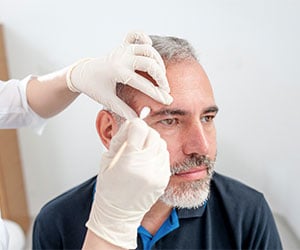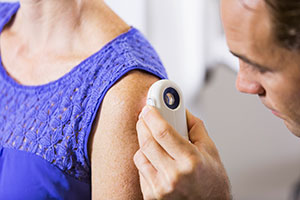Skin Cancer (Non-melanoma) Treatment Information
Moffitt Cancer Center excels in the treatment of virtually all types of cancer, including skin malignancies. Let’s take a closer look at skin cancer and its treatment options.
How common is skin cancer?
You may know that skin cancer is fairly widespread, but how common is it, exactly? Skin cancer is the most common type of cancer in the United States and around the world, with an estimated 9,500 new cases diagnosed in the U.S. alone every day. Globally, more than one million cases are diagnosed every year.
Most Common Skin Cancer Areas
Skin cancer on the face, nose, ears and scalp are especially common because people regularly forget or forgo applying sunscreen to those areas - especially the scalp and ears. This is why it’s important to scan the whole body for abnormal moles and indications of skin cancer, not just looking for skin cancer on your arms, back and hands where you can easily spot the signs.

What are the risk factors for nonmelanoma skin cancer?
A risk factor is any behavior, condition or characteristic that can make an individual more likely to develop skin cancer. Several risk factors for squamous cell and basal cell skin cancers have been identified, including:
- Exposure to UV light – Over time, UV rays from the sun and artificial sources like tanning beds and sunlamps can damage cellular DNA and spur cancer growth. Enjoy the sun safely by properly applying a broad spectrum sunscreen with an SPF of 15 or higher and wearing protective clothing.
- Advanced age – Anyone can develop nonmelanoma skin cancer, but it most often affects older adults.
- Fair complexion – Light skin contains less melanin, the protective skin pigment that can lower the risk of skin cancer.
- Skin inflammation or injury – Cancer is more likely to develop on scars from burns, skin above bone infections and areas of inflammatory skin diseases.
Risk factors for Merkel cell carcinoma also include UV light exposure, older age and fair skin, as well as infection with the Merkel cell polyomavirus (MCV).
Having one or more of the above risk factors doesn’t necessarily mean that developing skin cancer is inevitable, and it’s possible to develop skin cancer without having any established risk factors. Still, individuals who are at an increased risk should be particularly mindful of changes in their skin and promptly speak with a physician should any occur.
What are the symptoms of nonmelanoma skin cancer?
Nonmelanoma skin cancer can present as an unusual change in the skin, such as a:
- Wart-like growth
- Sore that may bleed, ooze or crust and remain open for several weeks
- Raised, reddish patch
- Growth with raised edges
- Bump that may appear pink, blue, red, white, shiny or translucent
- Raised, scaly rash
Comparatively, melanoma skin cancer typically appears as a pigmented mole or blemish that gradually changes shape, color or size.
Nonmelanoma Skin Cancer vs. Benign Skin Cancer
Nonmelanoma skin cancer usually appears on the face, lips, nose, scalp, ears and other areas of the body that are frequently exposed to sunlight, such as the arms, hands, legs, back and chest area. Still, it’s possible for skin cancer lesions to form anywhere, including unexpected places like the breasts, genital area and bottoms of the feet.
Many skin growths are benign (not skin cancer), but only a medical professional can rule out cancer and recommend appropriate treatment.
Are there differences between melanoma and nonmelanoma skin cancer?
 The most serious type of skin cancer, melanoma begins in melanocytes, the skin cells that produce the melanin pigment that gives the skin its color. Nonmelanoma skin cancer develops in other skin cells, such as:
The most serious type of skin cancer, melanoma begins in melanocytes, the skin cells that produce the melanin pigment that gives the skin its color. Nonmelanoma skin cancer develops in other skin cells, such as:
- Basal cells – Found at the bottom of the epidermis, basal cells produce new skin cells, which push older cells toward the skin’s surface, where the cells then die and shed.
- Squamous cells – Found in the tissue that forms the surface of the epidermis, squamous cells are thin, flat cells that resemble fish scales.
- Merkel cells – Found immediately below the epidermis, Merkel cells are located near nerve endings and serve as touch receptors.
While nonmelanoma skin cancer is generally considered to be less dangerous than melanoma, it can still progress, spread and cause disfigurement if left untreated. Therefore, early detection is key to preventing severe complications from any type of skin cancer.
What are the types of nonmelanoma skin cancer?
The three main forms of nonmelanoma skin cancer are:
Basal cell carcinoma
The most common type of skin cancer, basal cell skin cancer (carcinoma) begins in the skin’s basal cells. The cancer cells can form a lesion that appears as a white or pink patch, a waxy bump, an open sore or an elevated scar-like growth, typically on an area of skin that is regularly exposed to the sun, such as the head or neck. At times, the skin lesion may bleed, ooze or crust over.
Basal cell carcinoma tends to be slow-growing; however, if left untreated, it can become locally invasive and grow deep into the skin as well as the underlying tissues and bones.
Squamous cell carcinoma
The second-most common type of skin cancer, squamous cell carcinoma originates in the skin’s squamous cells. A lesion may appear as a thickened or scaly patch of skin, a wart-like bump or raised growth with a depression in the center. Although squamous cell carcinoma often develops in sun-exposed skin, it can also occur in other areas, such as the genitals, the soles of the feet and between the fingers and toes.
In many cases, squamous cell carcinoma can be successfully treated, but if it is allowed to progress, it can potentially become invasive, grow into deep skin layers and spread to other parts of the body.
Merkel cell carcinoma
A rare but potentially serious form of nonmelanoma skin cancer, Merkel cell carcinoma typically presents as a rapidly growing pimple-like lump that may be red, pink, pearly or blue-tinged. The tumors usually appear on sun-exposed skin. This type of skin cancer often occurs on the face, head and neck.
While Merkel cell carcinoma can be aggressive, it can often be effectively treated when detected early.
How is nonmelanoma skin cancer diagnosed?

Most nonmelanoma skin cancers are diagnosed after being noticed by the patient and brought to the attention of a physician. The only way to reach a conclusive skin cancer diagnosis is to perform a biopsy, which involves removing a small sample of abnormal tissue for analysis by a pathologist under a microscope. During a biopsy, a suspicious lesion may be removed in its entirety, if possible, along with a slim margin of surrounding tissue.
What are the treatment options for nonmelanoma skin cancer?
If an entire lesion is removed during a biopsy and a pathologist finds no evidence of cancer in the margin, no further treatment for nonmelanoma skin cancer may be needed. Otherwise, skin cancer surgery may be suggested, such as Mohs micrographic surgery, cryosurgery, a shave excision or an electrodesiccation and curettage. Mohs surgery is offered in conjunction with the USF Department of Dermatology. Radiation therapy or topical chemotherapy may be considered to address a tumor that cannot be surgically treated, along with immunotherapies that can elicit an immune response against the cancer.
Survival rate for nonmelanoma skin cancer
The overall prognosis for squamous cell and basal cell carcinomas is excellent, particularly when the cancer is diagnosed in an early stage. If left untreated for an extended period, however, it’s possible for the cancer progress to cause disfigurement or become life-threatening. Individuals who are older or who have compromised immune systems have an increased chance of experiencing complications from nonmelanoma skin cancer.
Merkel cell carcinoma is the most dangerous type of nonmelanoma skin cancer, with an average five-year survival rate of 63%. Several factors can influence this figure—for instance, the survival rate rises to 76% when Merkel cell carcinoma is diagnosed and treated in an early stage.
A renowned skin cancer center in Florida
A nationally recognized cancer research leader, Moffitt Cancer Center offers the latest treatments—both traditional and progressive—for all types of melanoma and nonmelanoma skin cancers. We are honored and proud to be the only National Cancer Institute-designated Comprehensive Cancer Center based in Florida, a distinction that speaks directly to our commitment to research and innovation.
The multispecialty team in Moffitt’s Cutaneous Oncology Program includes experts in all facets of skin cancer diagnosis and treatment, such as dermatology, radiology, dermatopathology, radiation oncology and surgical oncology. Our tumor board meets regularly to review complex cases, and every patient receives an individualized treatment plan that considers his or her unique care preferences. Moffitt has disrupted the traditional skin cancer care model, providing our patients with rapid care so they can start treatment right away and achieve the best possible outcome and quality of life.
To request an appointment with a specialist in our trailblazing skin cancer center in Florida, call 1-888-663-3488 or complete our new patient registration form online. As a new patient, you can feel confident that we will connect you with a cancer expert promptly, and you will often hear back from one of us as soon as possible.
